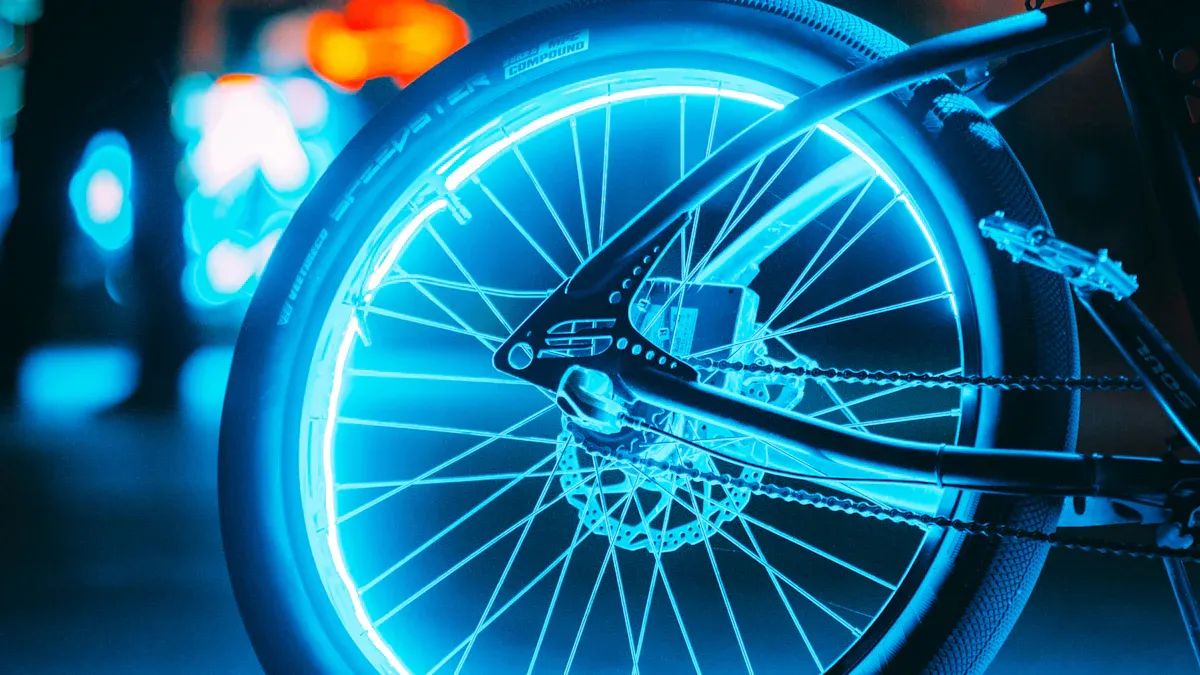The Best Flashlight for Cyclists: Enhancing Visibility and Safety

Cycling without proper lighting compromises your safety. A reliable flashlight enhances your visibility and reduces accident risks.
It illuminates obstacles, ensuring a safer ride.
It makes you noticeable to others, preventing collisions.
Cyclists using lights consistently report fewer accidents. The helius flashlight, for example, offers excellent visibility for both daytime and nighttime rides.
Key Takeaways
A good flashlight is important for keeping cyclists safe. It helps others see you and lowers accident chances.
Pick a flashlight that fits where you ride. City riding needs 50-200 lumens, but trails or night rides need 600-1000 lumens.
Buying a strong flashlight makes riding safer. It also follows bike rules and makes your rides better.
Top Flashlights for Cyclists

Best Overall Front Light: Knog Blinder 1300
If you're looking for the best overall front light, the Knog Blinder 1300 stands out as a top contender. Its one-piece alloy body ensures durability, while the IP67 waterproof rating makes it reliable in harsh weather conditions. With a brightness of 1300 lumens, this light provides exceptional visibility, even in low-light environments. The unique beam design enhances side visibility, ensuring you're seen from multiple angles. A built-in battery indicator keeps you informed about charge levels during your ride, adding convenience.
Why cyclists love it:
USB-C charging for faster and modern recharging.
Adjustable light angle for versatile use.
High performance in wet conditions.
These features make the Knog Blinder 1300 one of the best front bike lights for both safety and functionality.
Best Budget-Friendly Option: Ion 200 RT
For cyclists seeking affordability without compromising quality, the Ion 200 RT is an excellent choice. Here's a quick breakdown of its features:
Feature | Description |
|---|---|
Size | Small size for unobtrusive mounting |
Visibility | High visibility flash pattern |
Price | Affordable price point |
Intended Use | Designed for daytime visibility |
Battery Life | 12-30 hours |
Weight | 33.0g / 1.16 oz |
This compact light is perfect for daytime rides, offering reliable performance at a budget-friendly price.
Best Flashlight for Night Cycling: Garmin Varia
Night cycling demands a light that prioritizes safety, and the Garmin Varia delivers. Its rear radar detects vehicles up to 150 meters away, providing timely alerts through audible and visual warnings. The light adapts its brightness based on the speed of approaching vehicles, ensuring you're visible to drivers. Tested over 1000 days, this flashlight has proven its reliability in various conditions. Cyclists report feeling more confident and secure, especially when sharing the road with silent electric vehicles.
The Garmin Varia is one of the best bike lights for night rides, combining advanced technology with practical safety features.
Key Features to Consider

Brightness (Lumens) for Visibility
Choosing a flashlight with sufficient brightness ensures safety visibility in various cycling conditions. Lumens measure the light output, and your choice should depend on where you ride:
Urban commuting: 50 to 200 lumens work well in well-lit areas.
Rural roads or low-light suburbs: 200 to 600 lumens provide better visibility.
Mountain biking or off-road trails: A minimum of 1000 lumens is essential for navigating dark trails.
Daytime riding: 200 to 600 lumens with a day flash mode enhance visibility even in daylight.
A flashlight with adjustable brightness levels offers flexibility, allowing you to adapt to changing environments. This ensures you maintain safety visibility at all times.
Battery Life and Charging Options
Battery life is critical for ensuring your flashlight lasts throughout your ride. Most cycling flashlights use Li-ion batteries due to their excellent energy-to-weight ratio and long run times. They are rechargeable, low-maintenance, and cannot be overcharged. However, they have a fixed life cycle, so older batteries may offer reduced performance.
Battery Type | Chemistry | Voltage | Capacity Range | Rechargeable |
|---|---|---|---|---|
Ni-MH | Nickel-Metal Hydride | 1.2V | 500mAh - 10000mAh | Yes |
Li-ion | Lithium-ion | 3.6V - 3.7V | 500mAh - 20000mAh | Yes |
Alkaline | Alkaline | 1.5V | 1500mAh - 3000mAh | No |
USB-rechargeable flashlights are convenient for commuting and shorter rides. They offer confidence in battery life for evening rides but require recharging after use, which may not suit longer trips.
Mounting Options for Safety and Adjustability
Secure mounting ensures your flashlight stays in place during your ride. Adjustable mounts allow you to direct the beam where needed, enhancing safety visibility. Some of the best options include:
Universal Mounting Brackets, like the LED Lenser 7 series, which allow easy adjustment in all directions.
Twofish Lockblocks, ideal for small lights, known for their durability.
DIY solutions like conduit clamps, which can be bolted directly to your bike's front rack.
These options ensure your flashlight remains stable, even on bumpy roads, while offering flexibility for optimal lighting angles.
Weather Resistance and Durability
Cycling flashlights must withstand harsh weather and rough handling. Materials like aluminum alloy and titanium alloy provide durability and resistance to corrosion.
Material | Properties |
|---|---|
Aluminum alloy | Strong, lightweight, and good heat conduction. |
Aerospace-grade aluminum | High tensile strength, anodizable, and corrosion-resistant. |
Titanium alloy | Stronger than aluminum, corrosion-resistant, but more expensive. |
Flashlights made from these materials ensure the best performance front light for long-term use, even in challenging conditions.
How to Choose the Right Flashlight
Assessing Your Cycling Needs
Your cycling habits determine the type of flashlight you need. For urban commuting, a flashlight with moderate brightness and a wide beam pattern works best. If you ride on rural roads or trails, prioritize a flashlight with higher lumens and a focused beam to illuminate distant obstacles. Consider whether you cycle during the day or night. Daytime riders benefit from flashlights with strobe or flash modes, while night cyclists need consistent, powerful lighting. Think about your bike type as well. A compact flashlight suits road bikes, while mountain bikes may require rugged, weather-resistant options.
Matching Features to Your Budget
Balancing features with your budget ensures you get the best value. High-end models like the brightest front light often include advanced features such as adaptive brightness and extended battery life. Budget-friendly options, like the Ion 200 RT, still provide excellent performance for commuting or daytime visibility. Evaluate what features matter most to you, such as USB charging, waterproofing, or mounting flexibility. Spending a little more upfront can save you from frequent replacements or upgrades.
Prioritizing Safety Features
Safety should always come first when choosing a front bike light. A good flashlight not only lights your path but also makes you visible to others. Look for models that meet these criteria:
Enhance your visibility to drivers, pedestrians, and other cyclists.
Withstand vibrations, impacts, and harsh weather.
In many areas, having a front and rear light is legally required for night or low-light cycling. Investing in a high-quality flashlight ensures compliance and peace of mind.
Ease of Use and Installation
A flashlight that’s easy to install and operate saves time and frustration. Models like the Lezyne Zecto Drive 250+ and Light & Motion Vya Pro Smart Headlight offer simple mounting systems and intuitive controls. The table below highlights some of the easiest options:
Model | Specs | Highs | Lows | Bottom Line |
|---|---|---|---|---|
Lezyne Zecto Drive 250+ | 250-lumen max output; USB-C rechargeable; 22-hour runtime in flash | Excellent build quality; Great run times | Lower brightness for serious night riding | Best for visibility at dusk and night with long battery life. |
Light & Motion Vya Pro Smart Headlight | 200-lumen max output; USB-A integrated charging | Auto-on/off sensor; Lightweight design | Limited to power lumens | Practical for commuters with automatic operation. |
Planet Bike Blaze 400 SLX | 400-lumen max output; Micro-USB charge port | Good beam cutoff; Easy to mount | Micro-USB port instead of USB-C | Budget-friendly and compact for city commuting. |
PDW Pathfinder USB | 400-lumen max output; Micro-USB charge port | Bike-centric beam cutoff; Compact | Lower lumen output for dark trails | Reliable charging option with good runtime for urban cycling. |
Choose a flashlight that fits your bike and riding style. A secure mount and user-friendly design ensure a hassle-free experience.
Cycling safely starts with ensuring you are visible to others and can clearly see your path. Investing in a high-quality flashlight tailored to your needs offers numerous long-term benefits:
Visibility: Keeps you safe by illuminating your route and making you noticeable.
Legal Requirements: Helps you comply with local cycling laws.
Enhanced Riding Experience: Extends your riding time, especially at night.
Emergency Situations: Provides a reliable light source for unexpected tasks.
Durability and Reliability: Withstands tough conditions for long-term use.
Choosing the right flashlight enhances your cycling experience and ensures safety. Make an informed decision to enjoy every ride with confidence and peace of mind.
FAQ
What is the ideal brightness for a cycling flashlight?
The ideal brightness depends on your environment. For urban areas, 50-200 lumens suffice. Off-road or night cycling requires 600-1000 lumens for better visibility.
How often should you charge your flashlight?
Charge your flashlight after every ride to ensure optimal performance. For longer rides, consider carrying a portable power bank for emergency recharging.
Can you use a regular flashlight for cycling?
Regular flashlights lack proper mounting and beam focus for cycling. Invest in a bike-specific flashlight for better safety, visibility, and convenience.
See Also
Brighten Your Journeys with Top High-Power Flashlights
Discover the Cyansky P50R: An Ultra Bright Flashlight
Selecting the Ideal Emergency Flashlight for Homeowners
